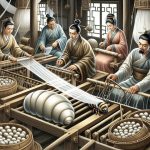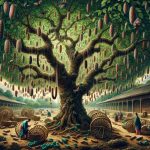Are you curious about what rose silk fabric is? Look no further! In this article, we’ll explore the history, characteristics, production process, and various types of rose silk fabric.
Discover the many uses and applications of this luxurious material, as well as tips for caring and maintaining it.
We’ll also compare rose silk fabric to other fabrics and discuss its sustainable and ethical aspects.
Get ready to dive into the world of rose silk fabric and unlock its secrets.
Table of Contents
History of Rose Silk Fabric
The history of rose silk fabric dates back to ancient China, where it was first created and popularized. Rose silk fabric production in China can be traced back to the Tang Dynasty (618-907 AD). During this time, the people of China discovered that rose petals could be used to extract a natural dye that could be used to color silk fabric. This led to the development of a unique textile known as rose silk fabric.
The production of rose silk fabric involves a meticulous process. First, the rose petals are carefully collected and then boiled to extract the dye. The silk fabric is then soaked in the dye, allowing it to absorb the vibrant colors. Finally, the fabric is washed and dried, resulting in a beautiful and luxurious material.
Rose silk fabric holds great cultural significance in China. It is often used to make traditional garments, such as qipaos, which are worn during special occasions and festivals. The vibrant colors and delicate patterns of rose silk fabric symbolize beauty, elegance, and femininity. Additionally, the use of rose petals in the production of the fabric adds a sweet and romantic touch.
Characteristics of Rose Silk Fabric
One unique aspect of rose silk fabric is its luxurious feel. When you run your fingers over rose silk fabric, you can instantly feel its soft and smooth texture, making it a delight to wear and touch.
However, the benefits of rose silk fabric go beyond just its feel. Here are some key characteristics of rose silk fabric that make it a popular choice:
-
Sustainability benefits: Rose silk fabric is made from the fibers of rose bushes, which are a renewable resource. This means that the fabric is eco-friendly and sustainable, as it does not require the use of harmful chemicals or pesticides.
-
Dyeing techniques: Rose silk fabric can be dyed using various techniques, allowing for a wide range of vibrant and beautiful colors. Whether it’s natural dyes or synthetic ones, the fabric absorbs the color evenly, resulting in rich and long-lasting hues.
-
Breathability: Rose silk fabric is highly breathable, which means that it allows air to flow through it easily. This makes it a great choice for clothing, especially in warmer climates, as it helps to keep you cool and comfortable.
Production Process of Rose Silk Fabric
If you’ve ever wondered how silk is made from roses, you’re in for a fascinating discussion.
The production process of rose silk fabric involves extracting fibers from the petals of roses and spinning them into thread.
This delicate and intricate process results in a luxurious fabric with a unique texture and appearance.
Silk From Roses
Silk can be made from roses, resulting in a luxurious and unique fabric called rose silk. This silk alternative offers several benefits that make it an attractive choice for those seeking a sustainable and eco-friendly option.
Here are some reasons why rose silk is worth considering:
-
Sustainability: Rose silk is made from the waste of rose petals, making it a sustainable option that minimizes waste and promotes environmental conservation.
-
Softness and comfort: Rose silk has a smooth and soft texture, providing a comfortable and luxurious feel against the skin.
-
Hypoallergenic properties: Rose silk is naturally hypoallergenic, making it an ideal choice for those with sensitive skin or allergies.
How Is It Made?
To create rose silk, the waste from rose petals is transformed into a luxurious and sustainable alternative fabric. The process begins with the extraction of fibers from the petals. These fibers are then spun into threads and woven into fabric using traditional silk production techniques. The resulting rose silk fabric has a soft and smooth texture, similar to traditional silk, but with a unique rose scent. It is also known for its durability and breathability, making it an ideal choice for clothing and accessories. The production of rose silk is not only environmentally friendly but also supports local communities, as it utilizes waste from the flower industry. Overall, rose silk is a truly innovative and sustainable option in the world of fabric production.
| Pros | Cons |
|---|---|
| Luxurious texture | Requires a large amount of rose petals |
| Sustainable alternative | Complex production process |
| Supports local communities | Limited availability |
Different Types of Rose Silk Fabric
You can find various types of rose silk fabric, each with its own unique characteristics and uses. When it comes to different colors, rose silk fabric offers a wide range of options to choose from. Some popular colors include vibrant red, soft pink, elegant white, and even deep purple. These colors can add a touch of elegance and sophistication to any garment or home decor item.
Benefits of rose silk fabric include its luxurious feel and its ability to drape beautifully. It has a natural sheen that gives it a lustrous appearance, making it perfect for special occasions and formal wear. Additionally, rose silk fabric is known for its breathability, keeping you cool in warm weather.
However, like any fabric, rose silk does have some drawbacks. One of the main drawbacks is its delicate nature. It requires special care and cannot be washed in a washing machine. Instead, it needs to be hand washed or dry cleaned, which can be time-consuming and expensive.
Uses and Applications of Rose Silk Fabric
Now that you know about the different types of rose silk fabric, let’s explore its uses and applications.
Rose silk fabric has gained popularity for its unique properties and versatility in various industries.
One of the advantages of rose silk fabric is its luxurious appearance and soft texture, making it a preferred choice for high-end fashion garments, such as dresses, blouses, and scarves. Its breathable nature also makes it suitable for summer clothing, allowing air circulation and keeping you cool.
Rose silk fabric is also used in home decor, including curtains, upholstery, and bedding. Its natural sheen adds a touch of elegance to any room, creating a sophisticated ambiance.
Furthermore, rose silk fabric is known for its hypoallergenic properties, making it an excellent choice for individuals with sensitive skin. It is less likely to cause irritation or allergic reactions compared to other synthetic fabrics.
However, there are also some disadvantages to consider. Rose silk fabric tends to be more expensive than other fabrics, making it less accessible to those on a budget. Additionally, it is delicate and requires special care during washing and handling to maintain its quality and longevity.
Care and Maintenance Tips for Rose Silk Fabric
Taking proper care of your rose silk garments and accessories is essential to maintain their quality and longevity. Here are some care and maintenance tips to help you keep your rose silk fabric looking its best:
-
Washing:
-
Hand wash your rose silk items in cold water with a gentle detergent.
-
Avoid soaking or rubbing the fabric vigorously to prevent damage.
-
Rinse thoroughly and gently squeeze out excess water, avoiding wringing.
-
Drying:
-
Lay your rose silk items flat on a clean towel to air dry.
-
Avoid direct sunlight or heat sources that can cause fading or shrinkage.
-
Do not hang your rose silk garments, as this can stretch the fabric.
-
Storage:
-
Store your rose silk items in a cool, dry place away from direct sunlight.
-
Avoid folding or hanging your rose silk items for long periods to prevent creases.
-
Use padded hangers or tissue paper to help maintain the shape of delicate pieces.
Comparison of Rose Silk Fabric With Other Fabrics
When comparing rose silk fabric to other fabrics, it’s important to consider factors such as durability, breathability, and texture.
Rose silk fabric offers numerous benefits in comparison to other fabrics. Firstly, in terms of durability, rose silk fabric is known for its strength and longevity. It can withstand regular wear and tear without losing its quality.
Secondly, breathability is another advantage of rose silk fabric. Its natural fibers allow air to circulate, keeping you cool and comfortable in warm weather. Additionally, rose silk fabric has a luxurious texture that feels soft and smooth against the skin. The gentle touch of rose silk fabric adds a touch of elegance to any garment or bedding.
In comparison to other fabrics, rose silk fabric stands out for its ability to regulate body temperature. It keeps you warm in the winter and cool in the summer, making it a versatile choice for all seasons. Moreover, rose silk fabric is hypoallergenic and gentle on sensitive skin. It is less likely to cause irritation or allergic reactions, making it suitable for those with allergies or skin sensitivities.
Sustainable and Ethical Aspects of Rose Silk Fabric
When considering the environmental impact of rose silk fabric, it’s important to note that the production process involves the use of natural dyes and non-toxic chemicals, making it more eco-friendly than other fabrics.
Additionally, rose silk fabric is biodegradable, reducing its impact on landfills.
Fair trade certification ensures that the workers involved in the production of rose silk fabric are paid fair wages and work in safe conditions, making it an ethical choice for consumers.
Environmental Impact of Rose Silk
Did you know that wearing rose silk fabric has a significant environmental impact? Here are a few reasons why:
-
Environmental sustainability: The production of rose silk fabric requires a large quantity of resources, such as water and energy, which can contribute to environmental degradation and resource depletion.
-
Carbon footprint: The process of growing roses and extracting silk fibers releases greenhouse gases, contributing to climate change. Additionally, the transportation and manufacturing processes further increase the carbon footprint associated with rose silk fabric.
-
Chemical usage: To extract silk fibers from rose petals, chemical solvents are often used. These chemicals can have harmful effects on the environment, including water pollution and soil contamination.
Considering these factors, it is important to be aware of the environmental impact of rose silk fabric and to make sustainable choices when it comes to fashion and textiles.
Fair Trade Certification
To make ethical and sustainable choices in your fashion purchases, you should consider looking for fair trade certification.
Fair trade benefits both the workers and the environment by ensuring fair wages and safe working conditions. When a product is fair trade certified, it means that it was produced in a way that promotes social and environmental responsibility. This certification guarantees that the workers involved in the production process were treated with respect and paid fair wages.
Additionally, fair trade certification ensures that the products were sourced in an ethical manner, without exploiting workers or harming the environment. By choosing fair trade certified products, you can be confident that your fashion choices align with your values of fairness and sustainability.
Conclusion
In conclusion, rose silk fabric is a luxurious and eco-friendly option for those who appreciate the beauty of nature. Its soft and smooth texture, combined with its unique ability to retain moisture and reduce wrinkles, makes it a popular choice in the fashion industry.
With its sustainable production process and ethical considerations, rose silk fabric offers a guilt-free alternative to traditional silk. Whether used in clothing, home furnishings, or accessories, rose silk fabric is sure to add a touch of elegance and sophistication to any setting.
- The Use of Nonwovens in Construction and Civil Engineering - July 11, 2025
- The Use of Nonwovens in Construction and Civil Engineering - July 11, 2025
- The Use of Nonwovens in Construction and Civil Engineering - July 11, 2025





